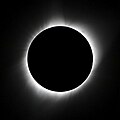| Total eclipse | |
| Gamma | −0.2396 |
|---|---|
| Magnitude | 1.0805 |
| Maximum eclipse | |
| Duration | 449 s (7 min 29 s) |
| Coordinates | 7°24′N46°30′W / 7.4°N 46.5°W |
| Max. width of band | 267 km (166 mi) |
| Times (UTC) | |
| Greatest eclipse | 15:14:54 |
| References | |
| Saros | 139 (39 of 71) |
| Catalog # (SE5000) | 9933 |
A total solar eclipse will occur at the Moon's ascending node of orbit on Sunday, July 16, 2186, with a magnitude of 1.0805. A solar eclipse occurs when the Moon passes between Earth and the Sun, thereby totally or partly obscuring the image of the Sun for a viewer on Earth. A total solar eclipse occurs when the Moon's apparent diameter is larger than the Sun's, blocking all direct sunlight, turning day into darkness. Totality occurs in a narrow path across Earth's surface, with the partial solar eclipse visible over a surrounding region thousands of kilometres wide. Occurring about 3 minutes before perigee (on July 16, 2186, at 15:20 UTC), the Moon's apparent diameter will be near its maximum. [1]
Contents
- Extreme duration
- Responses
- Eclipse details
- Eclipse season
- Related eclipses
- Eclipses in 2186
- Metonic
- Tzolkinex
- Half-Saros
- Tritos
- Solar Saros 139
- Inex
- Triad
- Solar eclipses of 2185–2188
- Saros 139
- Metonic series
- Tritos series
- Inex series
- References
- External links
This eclipse will be the longest total solar eclipse out of 6,326 calculated for 10,000 years between 4000 BCE and 6000 CE. The eclipse will pass over the southern Galápagos Islands (with a total eclipse of 4 minutes occurring over the southern tip of Española Island), the northern tip of Ecuador (with a total eclipse of 3 minutes and 26 seconds on Isla Santa Rosa), central Colombia (4 minutes and 50 seconds over Bogota), central Venezuela, and northern Guyana (7 minutes and 4 seconds just north of Anna Regina). [2] [3]


























































































